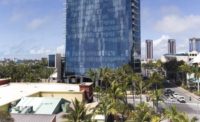Guardian Glass has published new Environmental Product Declarations (EPDs) for its flat unprocessed glass products and processed glass products produced in North America. Products covered include its range of float glass (clear, low-iron and tinted), sputter-coated glass (Guardian SunGuard™ architectural glass and Guardian ClimaGuard™ residential glass), wet coated glass, and heat-treated glass products.
The new North America unprocessed flat glass EPD has a cradle-to-gate (A1-A3) embodied carbon value of approximately 1102 kg CO2e/ton (TRACI 2.1 Method)*. This new value is:
- Approx. 23% lower than National Glass Association’s 2019 EPD value of 1430 kg CO2e/ton.
- Approx. 24% lower than Guardian Glass’ 2018 EPD value of 1455 kg CO2e/ton.
The new unprocessed flat glass value will help customers meet the top 20 percent limit in the U.S. General Service Administration’s ‘Low Embodied Carbon Material Standard’.
In parallel, Guardian Glass has introduced a new feature to its current Performance Calculator tool, which allows users to calculate the embodied carbon for the glazing configurations they select. This online tool (part of Glass Analytics) enables the modeling of the thermal and optical properties of glass substrates, coatings and interlayers. The new Performance Calculator feature provides an estimate of the embodied carbon equivalent for a wide number of glazing combinations, as it is available for most float glass and sputter-coated glass products produced by Guardian Glass in North America, South America, Europe and Africa Middle East (AME).
Using the Performance Calculator, the user configures a suitable glazing make-up and can view the corresponding estimated embodied carbon equivalents** for the configured glazing (only for the glass components manufactured by Guardian Glass, not for additional glass processing such as tempering, or components in the build-up such as spacers or frame). The glazing can range from monolithic glass to multiple layers of glass and coatings. Multiple glass configurations and options can be compared, allowing the user to better understand the impact of, for example, additional layers of glass or the incorporation of a high-performance coating.
Alan Kinder, Commercial Segment Director in North America comments: “We are excited to increase visibility for the embodied carbon value of our glass products for architects and glass processors. By increasing the understanding and accessibility to the environmental impact profile of our glass and coatings, we can help our partners make informed glass specification decisions earlier in the design stages for a positive impact on the performance of their facades. Our new EPDs demonstrate our commitment to Environmental Stewardship.”
Download the new EPDs on guardianglass.com/product-declarations.
Access to Glass Analytics and the embodied carbon calculator feature is via the Resource Hub on the Guardian Glass website guardianglass.com/resource-hub.
* Global Warming Potential of the A1-A3 stages includes the impacts from the raw materials extraction and processing stage, raw materials transportation to the manufacturing site, and the manufacturing of the product. This term is sometimes referred to as the “product carbon footprint” or “embodied carbon.”
**The embodied carbon data is the carbon equivalent in kg per ton or square meter of glass (CO2 eq.), emitted during the glass production (cradle-to-gate, A1-A3). The calculation is an estimation based on the material’s Embodied Carbon Factor (ECF) which were derived from the scaling factors and results in the Regional Environmental Product Declarations (EPDs), third-party, independently verified documents that communicate transparent information about the lifecycle environmental impacts of a product.





